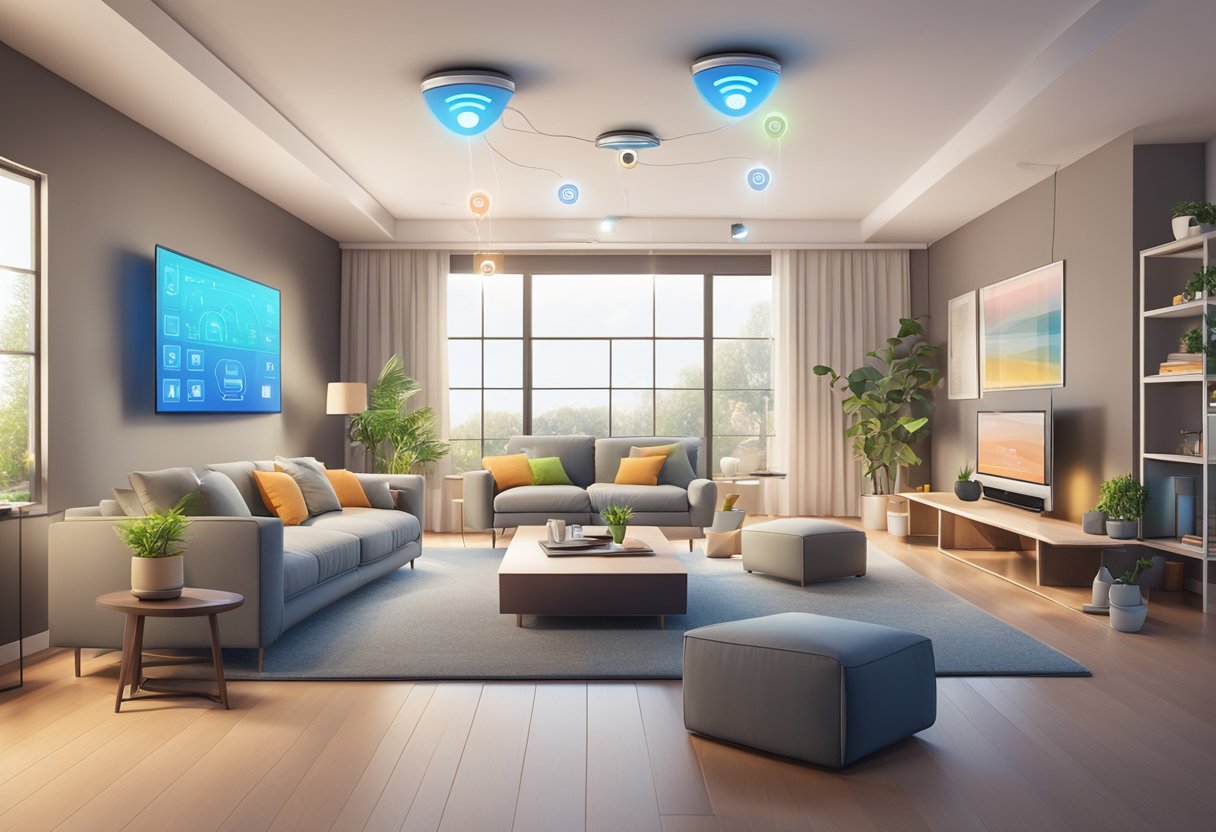How to Set Up a Smart Home: A Step-by-Step Guide for Beginners
Setting up a smart home can transform everyday living, making it more efficient, convenient, and secure. By integrating smart devices with a reliable network and a selected voice assistant, anyone can automate tasks and enhance their home environment. With various devices available, from smart lights to security systems, the possibilities are endless.

Starting with a few essential devices is the best approach. By choosing compatible products that work well together, he or she can create a seamless smart home experience. Additionally, focusing on security and ease of control is key to maximizing the benefits of smart technology.
As new devices become available, expanding a smart home is simple and can provide even more convenience and automation over time.
Key Takeaways
- A smart home enhances convenience and security through automation.
- Selecting compatible devices and a robust network is essential.
- Regular updates and maintenance keep a smart home efficient and secure.
Understanding Smart Home Basics
A smart home integrates technology to provide convenience and control over various systems. This section explores the definition of a smart home ecosystem and the key benefits of home automation.
Defining a Smart Home Ecosystem
A smart home ecosystem consists of devices that work together through a central hub and can be controlled via smartphone apps or voice commands. Common devices include smart lights, thermostats, security cameras, and smart plugs.
Key components involve:
- Smart Hub: This device connects all smart devices, allowing them to communicate.
- Connectivity: Most devices connect via Wi-Fi, but some use Zigbee or Z-Wave.
When set up properly, these devices enhance home automation, making tasks easier and more efficient. Users can create routines that automate lighting, heating, and security based on personal schedules or preferences.
Benefits of Home Automation
Home automation offers several advantages that improve daily life. One major benefit is convenience. Smart homes allow users to control multiple devices from a single interface.
Additional benefits include:
- Energy Savings: Automated systems can adjust energy use, lowering bills.
- Increased Security: Smart cameras and alarms provide enhanced safety options.
- Remote Access: Users can monitor and manage their homes from anywhere using an app.
These features make life easier and more efficient while also promoting a safer living environment.
Selecting Your Core Voice Assistant

Choosing a voice assistant is essential for making a smart home functional. Each assistant offers unique features and compatibility with various devices. The three main options are Amazon Alexa, Google Assistant, and Apple HomeKit. Here’s a closer look.
Amazon Alexa: The Centerpiece of Many Smart Homes
Amazon Alexa is widely recognized as a leading voice assistant. Its compatibility with numerous smart home devices makes it a popular choice. Alexa works seamlessly with smart speakers like the Amazon Echo, which allows users to control their home with voice commands.
Key features include:
- Wide Device Support: Alexa connects to thousands of smart home devices, ranging from lights to thermostats.
- Skills and Customization: Users can enable skills that enhance functionality, allowing for tailored control.
- Routines: Alexa can perform multiple actions with a single command, such as turning off lights and adjusting temperature simultaneously.
This versatility makes Amazon Alexa a strong foundation for smart home technology.
Google Assistant and Google Home Compatibility
Google Assistant champions convenience and integration with Google services. It operates smoothly on Google Home devices and supports many smart home gadgets.
Important features are:
- Natural Language Processing: Google Assistant understands context, making it easier to follow conversations.
- Smart Home Control: Users can manage devices through simple voice commands such as “Turn on the living room lights.”
- Device Compatibility: Google Assistant works with a variety of brands, ensuring a broad selection of smart home devices.
Google Assistant is an excellent option for users already invested in the Google ecosystem, enhancing their smart home experience.
Apple HomeKit: Integrating iOS into Your Home
Apple HomeKit is designed for users who prefer a seamless experience within the Apple ecosystem. It works with various smart devices, allowing for central control via iPhone, iPad, or HomePod.
Key points include:
- Security and Privacy: HomeKit emphasizes user security, ensuring that data is encrypted.
- Siri Integration: Users can issue voice commands through Siri to manage devices, like adjusting lights or checking security cameras.
- User-Friendly Interface: The Home app offers simple navigation for setting up and controlling smart home devices.
Apple HomeKit is ideal for those already using Apple products, providing smart home technology that integrates well with their devices.
Creating a Reliable Smart Home Network

A dependable smart home network is crucial for ensuring that all devices work seamlessly together. This involves selecting the right router, maintaining a strong Wi-Fi connection, and understanding alternative connections like Zigbee, Z-Wave, and Bluetooth.
Choosing the Right Router
Selecting an appropriate router is the first step in building a solid smart home network. It’s essential to choose a router that supports the latest Wi-Fi standards, such as Wi-Fi 5 or Wi-Fi 6. These standards provide better speed and efficiency.
When selecting a router, consider the following:
- Speed Ratings: Look for routers with high Mbps ratings.
- Dual or Tri-Band: A dual-band router can operate on both 2.4 GHz and 5 GHz bands, allowing more devices to connect without interruptions.
- Device Capacity: Make sure the router can support multiple connections.
Choosing a router that fits the household size and smart device count is critical for performance.
Ensuring a Strong Wi-Fi Connection
A strong Wi-Fi connection is vital for smart home functionality. Many smart devices require a stable connection to operate effectively. To ensure a reliable Wi-Fi network, consider these tips:
- Router Placement: Place the router in a central location in the home to minimize dead zones.
- Interference: Keep the router away from walls and other devices that may cause interference, such as microwaves or cordless phones.
- Mesh Networks: For larger homes, a mesh Wi-Fi system can help spread the signal evenly throughout the space.
It is advisable to regularly check the network speed and reliability using various online tools.
Understanding Zigbee, Z-Wave, and Bluetooth Connections
In addition to Wi-Fi, smart home devices often utilize Zigbee, Z-Wave, and Bluetooth for communication. Understanding these protocols can enhance network setup.
-
Zigbee: This is a low-power network standard ideal for devices that require less bandwidth. It is commonly used for smart lights and sensors and creates a mesh network for better range.
-
Z-Wave: Similar to Zigbee, Z-Wave is designed for smart home applications but typically operates at a longer range. It is also a low-power technology and connects devices directly to each other.
-
Bluetooth: While Bluetooth is often used for short-range connections, it can effectively control devices like speakers and locks from smartphones.
Choosing the right protocol depends on the specific devices in the smart home ecosystem.
Setting Up Essential Smart Devices
Creating a smart home involves choosing the right devices to enhance convenience and efficiency. Key areas to focus on include smart speakers and displays, intelligent lighting options, and advanced thermostats for energy management.
Smart Speakers and Displays
Smart speakers, like Amazon Echo or Google Nest, serve as the hub for voice control and automation. They connect to various smart devices and make it easy to control them using voice commands. Users can customize their setup with different routines, like dimming lights or playing music.
Smart displays, such as the Echo Show, provide visual feedback and interaction. This can include checking the weather, viewing security cameras, or managing calendars. It is crucial to place these devices strategically for optimal voice recognition and visibility.
Intelligent Lighting and Smart Plugs
Smart lighting includes products like smart bulbs and light strips. These can be controlled through apps or voice commands. Users can set schedules, change colors, and dim lights to fit their needs. Products from brands like Philips Hue or LIFX are popular choices.
Smart plugs allow traditional devices to become smart. Users can plug in appliances and control them remotely, which helps save energy. Both smart lighting and plugs enhance home automation and can be tailored to preferences, enhancing convenience.
Thermostats and Energy Monitoring
Smart thermostats, like the Nest Learning Thermostat, adjust temperature settings automatically based on user habits. This helps maintain comfort while reducing energy bills. They can be controlled remotely via smartphone apps, making it easy to adjust settings from anywhere.
Energy monitoring devices track energy consumption and provide insights. This allows users to identify energy-hogging appliances and make informed decisions. Combining smart thermostats with energy monitoring solutions leads to efficient energy use, contributing to a smarter home environment.
Securing Your Home with Smart Technology
Smart technology enhances home security by providing real-time surveillance, remote access, and automation. These tools not only deter intruders but also improve convenience and peace of mind for homeowners.
Advanced Security Cameras and Video Doorbells
Smart security cameras are essential for monitoring the home. They can record footage and send alerts to the homeowner’s devices. Many models offer features like night vision and two-way audio, allowing users to communicate with visitors remotely.
Video doorbells serve a similar function. They let homeowners see and talk to anyone at their door without opening it. With motion detection, these devices notify users when someone approaches, improving safety.
Common options include:
- Indoor cameras for monitoring living spaces.
- Outdoor cameras for covering entrances and backyards.
- Video doorbells for immediate door surveillance.
Integrating Smart Locks
Smart locks offer convenient keyless entry. They allow homeowners to unlock doors using smartphones or keypads. These locks can automatically lock when the user leaves, enhancing security without needing to remember to lock up.
Many smart locks work with security systems. This integration adds layers of protection, like alerting homeowners if a door is left open. Features often include:
- Temporary access codes for guests or service providers.
- Remote locking and unlocking capabilities.
- Activity logs to track who enters and exits the home.
Automation for Home Security Systems
Home security systems benefit greatly from automation. Homeowners can program their systems to activate when they leave, ensuring all doors are locked and cameras are operational. Automation allows for customized settings based on daily routines.
Many systems integrate with other smart devices. For example, linking smart lights can simulate occupancy, deterring potential intruders. Automation also enables homeowners to receive alerts on unusual activities, helping them respond quickly.
Key features may include:
- Scheduled arming and disarming of the system.
- Remote monitoring through smartphone apps.
- Integration with emergency services for rapid response.
Optimizing Smart Home Control
Optimizing smart home control involves enhancing how devices work together and are managed. This can include programming routines, using smart home apps for remote management, and leveraging smart home hubs effectively.
Programming Routines and Automations
Creating routines allows users to automate multiple tasks with one command. For instance, a morning routine could include turning on lights, starting the coffee maker, and adjusting the thermostat. This streamlines daily activities.
Smart home platforms like Amazon Alexa and Google Home support routines. Users can set specific times for actions to occur or trigger them through voice commands. Automation can also be expanded with services like IFTTT, which connects devices based on conditions. For example, lights can turn on automatically when a door is unlocked.
Remote Management via Smart Home Apps
Smart home apps are essential for managing devices from anywhere. They provide a central interface for controlling all smart home systems. Users can check security cameras, adjust lighting, or control temperature remotely.
Apps usually offer features like device grouping for managing multiple devices at once. Notifications can alert users to unusual events, such as doors opening or motion detected. Voice control can also be integrated, making it easy to give commands even while away from home.
The Role of Smart Home Hubs and Platforms
Smart home hubs serve as the backbone of a smart home system, connecting various devices. They allow for better interoperability between devices from different brands. This makes the management process smoother and reduces compatibility issues.
Some popular smart home hubs include Amazon Echo, Google Nest, and Apple HomeKit. Each platform supports different features and can manage various devices efficiently. With the emergence of Matter, a new standard for smart home products, compatibility among devices will improve, making control more seamless. Hubs can enhance the user experience by allowing complex automations that individual devices might not support alone.
Expanding Your Smart Home
Expanding a smart home involves integrating more devices and ensuring they work together smoothly. This section explores connected appliances, the Internet of Things (IoT), and compatibility to create a more efficient living space.
Connected Appliances and Robots
Adding smart appliances can enhance convenience and efficiency. Devices like smart refrigerators and washing machines allow users to monitor and control functions remotely.
Robot vacuums are popular choices too. They can clean floors automatically, following scheduled tasks. For instance, brands like Roomba offer models that can be controlled via a smartphone app, helping maintain cleanliness without manual effort.
When selecting smart home gadgets, consider those that connect easily to the network. Products from brands such as Philips Hue for lighting or Tado for heating provide flexibility and energy savings. These appliances work to make daily tasks easier and more enjoyable.
Towards an Integrated Internet of Things (IoT)
The Internet of Things (IoT) plays a crucial role in expanding smart home capabilities. It involves connecting devices so they can communicate with each other. This interaction creates a cohesive system that can be controlled from a single platform.
For example, a smart thermostat can adjust the temperature based on data from smart sensors throughout the home. As a result, this integration not only enhances comfort but also optimizes energy use.
Users can also access their devices remotely through Android devices or other smart platforms. This flexibility empowers total control over the home, regardless of location, making life easier and more convenient.
Compatibility and Future-Proofing
When expanding a smart home, ensuring compatibility among devices is vital. Choosing products that work well within a smart home ecosystem minimizes technical issues.
Before purchasing, consumers should research compatibility of devices with existing systems. This step helps in avoiding frustration later. Schedules and routines can be managed more effortlessly when devices interconnect smoothly.
Future-proofing also matters. Investing in devices that support the latest standards will keep a smart home relevant for years. For instance, simple wireless standards like Wi-Fi or Zigbee can help maintain compatibility with newer devices as the market evolves.
In short, expanding a smart home requires careful selection of devices and attention to how they will work together.
Maintaining Your Smart Home

Keeping a smart home running smoothly involves regular troubleshooting and timely updates. These actions ensure that the connected devices perform well and stay secure. This section focuses on common issues and the importance of software updates.
Troubleshooting Common Issues
Smart home devices can sometimes face challenges, but many issues are easy to fix. First, check the Wi-Fi connection. A stable connection is crucial for smart devices like those controlled by SmartThings or a home assistant. Restarting the router can resolve many issues.
If a device isn’t responding, try power cycling it. Unplugging and plugging it back in often helps. Also, ensure that devices are within range of the router or any Thread network.
Another common issue is app connectivity. If a device isn’t showing in the app, ensure it’s powered on and connected. Checking for device-specific settings within the app can also be beneficial. Documenting recurring issues can help in seeking technical support later.
Software Updates and Technical Support
Regular software updates are vital for maintaining a smart home. They often bring new features, improved performance, and security patches. Users should enable automatic updates, if available, to keep devices current without manual effort.
If problems arise that updates do not fix, contacting technical support is the next step. Most manufacturers provide resources, including online FAQs and chat support. Users can troubleshoot issues based on device-specific information.
Also, user forums are helpful for advice from others. Engaging with the community can lead to solutions for commonly faced problems. Maintaining open communication with device support can ensure a reliable smart home experience.
Frequently Asked Questions
Setting up a smart home can raise many questions. This section provides clear answers to common inquiries regarding essential components, planning steps, integration with devices, and managing multiple gadgets.
What are the essential components needed to start building a smart home?
To start building a smart home, key components include a reliable Wi-Fi network and smart devices. These devices can range from smart speakers and lights to smart thermostats and cameras. Smart hubs may also be helpful for easier device management.
What steps are involved in creating a smart home plan?
Creating a smart home plan begins with identifying specific needs. Next, one should research devices that meet those needs and check compatibility. Finally, it is important to create a budget and decide on a timeline for setup.
How can I integrate Amazon Alexa into my smart home setup?
To integrate Amazon Alexa, users should purchase Alexa-compatible devices. After setup, they can download the Alexa app and connect devices through it. Voice commands can then control the devices as desired.
What should I look for when choosing a smart home setup service?
When choosing a smart home setup service, consider experience and customer reviews. It’s also important to check if the service offers customization and technical support. Transparency about pricing and service plans should be clear.
How do I connect and manage multiple smart home devices?
Connecting multiple smart home devices typically involves using their respective apps. A centralized hub, like a smart speaker, can help manage them. Users can create routines or group devices for easier control.
What are some smart home set-up ideas to enhance home automation?
Smart home setup ideas include installing smart lighting that adjusts to schedules and using smart plugs to control appliances. Automated thermostats can optimize energy use. Additionally, setting up security cameras can enhance home safety.






Post Comment